Final Report for ONE13-179
Project Information
This project evaluated the impact of post-plant applications of compost and forage radish cover crop on soil compaction in established blueberry and raspberry plantings. The compost and forage radish treatments were made in early fall 2013. In 2014 and 2015, the three cooperator growers and the PI collected harvest data from each treatment and rep immediately prior to each field being opened to pick-your-own. Penetrometer readings, measured in pounds per square inch (psi) were taken in 5 locations at each treatment and rep at 0”- 6” depth, and at depths greater than 6” to hardpan or >300 psi, whichever came first, prior to treatments in spring 2013, and in June 2014 and 2015. Growth measurements were taken prior to treatments and again in September 2014 and 2015. Although the original project timeline did not include data collection for the 2015 season, it was determined the information would be beneficial because it may take longer than a single season for the treatment effects to be seen.
There were no statistical differences within the treatments at the 3 locations. There were no statistical differences between treatments for yield, growth and penetrometer readings at the organic blueberry field and the raspberry field, or in the yield and growth at the non-organic blueberry field. However there was a statistical difference in soil penetrometer readings in the 0-6 inch depth at the non-organic blueberry field in 2014 and 2015. In 2014, there was a statistical difference between the check and radish treatment with mean penetrometer readings of 133 lbs (check), 97 lbs (compost) and 88.33 lbs (radish). The compost treatment was not significantly different from the check or the radish treatment. In 2015, there was a statistical difference between the check and the two treatments (compost and radish) with mean penetrometer readings of 179 lbs (check), 106.67 lbs (compost) and 102.5 lbs (radish). The radish treatment had shown improvement in soil hardness in 2014 and 2015, while the compost treatment had shown improvement in soil hardness by 2015.
Introduction:
Long term perennial berry crops (highbush blueberry, brambles) are grown on over two thousand eight hundred acres in New England, of which five hundred eighteen acres are in Connecticut (USDA Census 2012). They generate high value since they are sold almost exclusively to the fresh market. Poor growth leads to reduced production and reduced grower revenue, and is the result of one or several factors including site related issues, soil fertility, soil compaction, plant damage from wildlife, insects and diseases, and abiotic disorders.
One of the factors leading to poor plant performance is soil compaction. It is measured as pounds per square inch (psi) using a penetrometer pushed into the soil to a depth of six inches (surface hardness/compaction) and a depth of six to eighteen inches (subsurface hardness/compaction). Root growth is restricted in moderately compact soils with a surface (0– 6 inch depth) penetrometer reading of 125-220 psi, and a subsurface (6 – 18 inches depth) penetrometer reading of 220 to 280 psi. Penetrometer readings greater than 220 psi (surface) and 300 psi (subsurface) are considered severely compacted soils (4).
Compacted soils have reduced pore space which causes a restriction in root growth (2, 15). Blueberry andbramble plants have fibrous root systems that do not easily penetrate compacted soils which can result inreduced plant growth. In addition, compacted soils have been shown to reduce water and nutrient uptake by plants, and in Wisconsin, research has shown potassium uptake is reduced in compacted soils (15), a high demand element that is critical in blueberry and bramble production (9, 10).
There are a number of reasons soils become compacted such as farm equipment driven over the arearepeatedly; driven over or worked when the soils were wet; or from excessive tillage.
As a part of a separate project through Cornell (NE SARE Soil Management Berry Project), soils in established berry fields were tested for a number of biological, physical and chemical parameters in 2012. Of the five Connecticut growers participating in the project, four out of the five have compacted soils in established berry fields as determined by penetrometer readings, as well as poor production and poor plant growth as determined by the growers. None of the Connecticut growers indicated they had used a penetrometer prior to planting to determine soil compaction.
There is extensive research supporting pre-plant cover crops and incorporation of compost for alleviating soil compaction for annual cropping systems as well as for pre-plant soil management in berry crops. (6, 7, 8, 12, 15, 16) There is a void of research investigating methods to alleviate post-plant soil compaction in a perennial planting system within the plant row. Work by Guong et al (5) examined the addition of compost to compacted soils in older citrus plantings and concluded that it reduced soil compaction and increased fruit yield. There is no indication of the length of time it took for this to occur. An on-going study in California in a 3.3 acre established orchard with severely compacted soil has shown that top dressing with compost has begun to lessen the soil compaction after a year. (3)
This study will investigate two treatments in addition to the untreated check: the effectiveness of a forage radish cover crop system, and, surface application of compost. The treatments will be applied within the plant row in three established berry fields, replicated three times at each site, to determine if they reduce soil compaction.
Compost applied to the soil surface within the plant row will attract soil microbes that decompose the compost and aerate the soil as they move through the soil profile, a process that will increase soil pore space and soil organic matter content over time. (3,5,10) Incorporating compost throughout the root zone provides more immediate results, (7,8) but is not practical in an established berry field due to the shallow root systems of berry plants. Compost selected by the grower cooperators, will be tested for nutrient content prior to its application to avoid grower over-application of other fertilizers. Compost application will be made in early September.
When looking for a cover crop for this study, there were two requirements – that it winter kill to reduce competition with the berry plants for water and nutrients in the spring as well as the need for herbicide or hand weeding, and that the cover crop be known for alleviating soil compaction. Brassica cover crops with large tap roots, are known for alleviating soil compaction, and are expected to winter kill in the northeast. The forage radish is a brassica, a tender plant that is expected to winter kill, decomposes rapidly in the spring, and is known to grow one to two feet in length penetrating compacted soils. (1,4,11,13) The forage radish will be planted in early-September within the established plant row at a time when the berry plants are slowing growth for the season. Soil compaction is expected to be reduced the growing season following seeding.
Collaborators on this project were Ms. Dina Brewster, The Hickories, Ridgefield, CT; Mr. Russell Holmberg, Holmberg Orchards, Gales Ferry, CT; Mr. Peter Concklin, Raspberry Knoll Farm, N. Windham, CT; and Dr. John Inguagiato, UConn, statistical data analysis.
- Bjorkman, T. 2010. Cover Crop Series, Factsheet: Forage Radish. Cornell Cooperative Extension
- Cox, B. & M. McKellar (eds). 2012. Field Crops Management Guide, Chapter 2.7. Soil Compaction. Cornell University
- Debasitis, B. 2009. Compost Use Case Study: Weed Abatement and Soil Restoration, The Historic Orchard at Guadalupe River Park and Gardens. urbancompost.com
- Gugino, B.,J. Idowu, R.R. Schindelbeck, H.M. van Es, D.W. Wolfe, B.N. Moebius-Clune, J.E. Thies, and G.S. Abawi. 2009. Soil Health Assessment Training Manual. Cornell University.
- Guong, V., N. Hien & D. Minh. 2010. Effect of Fresh and Composted Organic Amendments on Soil Compaction and Soil Biochemical Properties of Citrus Orchards in the Mekong Delta, Vietnam. World Congress of Soil Science. Brisbane, Australia.
- Hoorman, J. 2009. Using Cover Crops to Improve Soil and Water Quality. Ohio State University.
- Pritts, M. 2012. Cover Crops for Blueberry Plantings. Cornell University.
- Pritts, M. 2012. Cover Crops for Raspberry Plantings. Cornell University.
- Pritts, M & J. Hancock (eds). 1992. Highbush Blueberry Production Guide. NRAES-55. New York
- Pritts, M. & D. Handley (eds). 1989. Bramble Production Guide. NRAES-35. New York
- Reeder, R. 2012. Cover Crops Ease Soil Compaction. Ohio State University
- Sanchez, E. & K. Demchak. 2004. The Organic Way-Use of Compost and Manure in Small Fruit Production. Vegetable and Small Fruit Gazette, Vol. 8, No. 10, October 2004.
- Weil, R. 2010. Forage Radish: New Multi-Purpose Cover Crop for the Mid-Atlantic. Factsheet 824. Maryland Cooperative Extension.
- Weil, R. & S. Williams. 2003. Brassica Cover Crops to Alleviate Soil Compaction. U. of Maryland.
- Wolkowski, R. & B. Lowery. 2008. Soil Compaction: Causes, Concerns, and Cures. U. of Wisconsin Extension A3367.
- Wortmann, C. 2009. Management to Minimize and Reduce Soil Compaction. U. of Nebraska.
- Soil penetrometer readings were taken at each treatment and rep; 0-6” depth and >6” to hardpan or >300psi, whichever came first. Data was collected prior to the treatment in 2013, and again in June 2014 and 2015.
- Cane length and number of new canes for each blueberry bush, cane length and number of canes per 10’ of row in brambles was recorded prior to the treatment in the fall of 2013, and again in the fall of 2014 and 2015.
- Yield data was collected at each location immediately before the blocks were opened for pick-your-own in 2014 and 2015.
- August 2013, PI and the cooperator growers seeded the radish at the rate of 15 lbs. per acre. The radish was spread onto bare ground in the bramble and conventional blueberry block. It was planted through the sod by the use of a bar to poke holes, in the organic blueberry block.
- Prior to applications, compost samples were collected from each grower and sent to the UConn Soil Analytical Lab for analysis prior to application. This was done to aid the growers in their fertilizer programs although that aspect was not related to the project.
- Compost was spread evenly in a 2’-2.5’ wide band in the bramble row; spread evenly in a 2.5’-3’wide band in the conventional blueberry row, and in 2’ circle around the organic blueberries (grower mows around each plant).
- Pictures were taken at each site.
- Data was analyzed for differences between the treatments and differences within treatments using 3x2x3 factorial, randomized complete block.
- A field day at a cooperator farm was not held. There were no visual differences between treatments at harvest or with growth at the end of the season at any of the three farms.
- A factsheet was written in 2016 and distributed via email, newsletters, grower meetings, and on the UConn IPM website.
- The results of the project were incorporated into plant nutrition presentations made by the PI.
Cooperators
Research
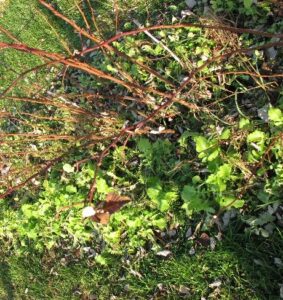 Raspberry forage radish treatment
Raspberry forage radish treatment 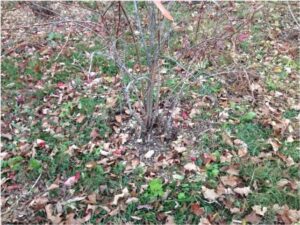 Organic blueberry radish treatment
Organic blueberry radish treatment 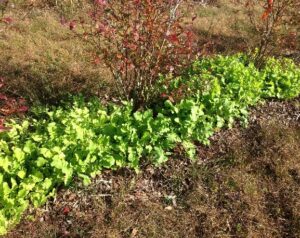 Non-organic blueberry radish treatment
Non-organic blueberry radish treatment 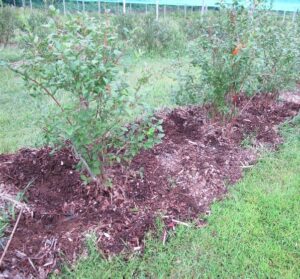 Non-organic blueberry compost treatment
Non-organic blueberry compost treatment 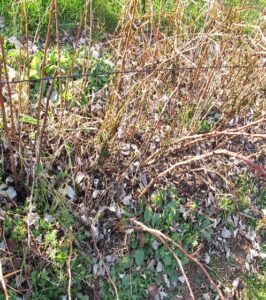 Raspberry co
Raspberry co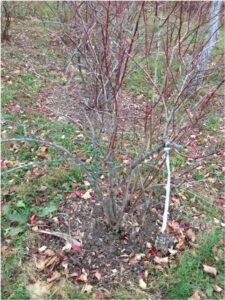 mpost treatment Organic blueberry compost treatment
mpost treatment Organic blueberry compost treatment
The PI and cooperating growers measured changes in soil compaction by comparing two treatments in addition to the check: {1} the effectiveness of a forage radish cover crop within the berry plant row; {2} top dressing compost within the berry plant row; and {3} an untreated check. The treatments were applied in August 29 & 30 and September 5, 2013 at three farms: an established raspberry field planted in 2010 on sandy loam soil; and two established blueberry fields, one planted in 2006 on gravelly loam soil, and a certified organic block planted around 1985 on fine sandy loam soil. Treatments were applied within the plant row, and replicated three times at each site. At the raspberry field each rep was 10 feet long for a total of 90 feet. At the two blueberry fields, each rep consisted of 3 bushes for a total of 27 bushes per farm.
There were two requirements for a cover crop for this study – that it winter kill to reduce competition with the berry plants for water and nutrients in the spring as well as the need for herbicide or hand weeding, and that the cover crop be known for alleviating soil compaction. The forage radish is a tender plant that quickly germinates when seeded in early fall, is killed with low winter temperatures and decomposes in a relatively short time in the spring. The large taproot, often growing to one to two feet, penetrates compacted soils, increases large pore spaces and decomposes quickly (14), increasing water and air filtration and opening soils for greater root penetration (1, 13). Expected timeline for reducing soil compaction and increasing soil pore space is within the first year with the forage radish. Other deep rooted cover crops, such as rye and oats, are not winter killed and will require herbicides or hand weeding in the spring to eliminate competition with the berry plants for water and nutrients, and therefore not under consideration.
Compost is well known for its ability to improve soil organic matter, water holding capacity, suppress weeds, reduce soil compaction and increase pore space through the activity of earthworms and soil microbes. As a pre-plant soil management tool for berry crops, compost is incorporated into the soil. (3, 5, 9, 10, 12) Incorporating compost throughout the root zone provides more immediate results, (7,8) but is not practical in an established berry field due to the shallow root systems of berry plants. Unincorporated compost, expected to provide the same benefits, although not as quickly as incorporated compost, should begin to reduce soil compaction and increase the soil pore space during the first year after application as the soil microbes decompose the compost, with greater impact in years two and three. The compost was tested for nutrient content at the University of Connecticut’s soil analytical lab prior to its application. This allowed the grower cooperators to adjust additional nutrient applications s/he would make to the planting based on the soil test results that were obtained as part of the Cornell Berry Crop Soil Management project.
Base-line measurements of soil compaction (penetrometer readings) were taken in June 2013 in the three treatment areas. Each treatment was replicated three times for statistical analysis. Plant growth measurements were recorded just prior to treatment applications on August 29 and 30, 2013 to provide a measurement of growth during the 2013 season.
The radish seeding was accomplished August 29 and 30, 2013 at the rate of 15 lbs/acre. Compost applications were made August 30, 2013 in the two blueberry fields and on September 5, 2013 in the raspberry field to a depth of two to three inches.
Yield data was collected for the three fields just prior to the fields opening for pick-your-own. Organic blueberry field: July 7, 2014 and July 9, 2015; Non-organic blueberry field: July 18, 2014 and July 17, 2015; Raspberry field: July 14, 2014 and July 13, 2015. The blueberries were picked into pint containers and the raspberries were picked into half-pint containers. The volume of fruit remaining on the plants was estimated.
Growth data – cane numbers and length - was collected for the three fields in September of 2014 and 2015.
Penetrometer readings were recorded at the depths 0-6 inches, and 6-18 inches or to the hardpan or 300 psi, whichever came first, in mid-late June of 2014 and 2015.
Statistical analysis was conducted by Dr. John Inguagiato, UConn, using 3x2x3 factorial randomized complete block.
Non-organic blueberry cane data Non-organic blueberry penetrometer data Non-organic blueberry yield data Organic blueberry Yield data Organic blueberry Cane Data Organic blueberry Penetrometer Data Raspberry Cane data Raspberry Penetrometer Data Raspberry Yield Data Statistics_Concklin_SARE
Each location was analyzed separately.
There was no statistical difference between or within treatments in the raspberry field and the organic blueberry field. Additional discussion below. There was a statistical difference between treatments at the non-organic blueberry field as seen in the data box below. Means with the same letter are not significantly different.
| Average Penetrometer Readings at two Depths in psi | ||||||
| Raspberry | ||||||
| 4/10/2013 | 6/9/2014 | 6/30/2015 | ||||
| 0-6" | 6-18" | 0-6" | 6-18" | 0-6" | 6-18" | |
| Check | 220.0 | 300.0 | 176.7 | 300.0 | 135.0 | 193.3 |
| Radish | 225.0 | 300.0 | 121.7 | 300.0 | 131.7 | 200.0 |
| Compost | 243.3 | 300.0 | 113.3 | 296.7 | 126.7 | 210.0 |
| Organic Blueberry | ||||||
| 4/11/2014 | 6/9/2015 | 6/22/2015 | ||||
| 0-6" | 6-18" | 0-6" | 6-18" | 0-6" | 6-18" | |
| Check | 190.0 | 295.8 | 196.7 | 253.3 | 133.3 | 240.0 |
| Radish | 185.0 | 300.0 | 172.0 | 285.0 | 108.3 | 241.7 |
| Compost | 150.0 | 289.0 | 161.7 | 300.0 | 133.3 | 246.7 |
| Non-organic Blueberry | ||||||
| 4/10/2013 | 6/9/2014 | 6/30/2015 | ||||
| 0-6" | 6-18" | 0-6" | 6-18" | 0-6" | 6-18" | |
| Check | 215.0 (A) | 282.5 (A) | 133.0 (A) | 241.6 (A) | 179.0 (A) | 242.0 (A) |
| Radish | 170.0 (A) | 292.5 (A) | 88.3 (B) | 218.3 (A) | 102.5 (B) | 190.8 (A) |
| Compost | 131.7 (A) | 290.0 (A) | 97.0 (AB) | 218.3 (A) | 106.7 (B) |
210.0 (A) |
|
Average # new canes |
|||
| Raspberry | |||
| 8/31/2013 | 9/30/2014 | 9/15/2015 | |
| Check | 62.7 | 40.7 | 52.7 |
| Radish | 57.7 | 50.7 | 51.0 |
| Compost | 65.7 | 51.3 | 59.3 |
| Organic Blueberry | |||
| 8/29/2013 | 9/18/2014 | 9/2/2015 | |
| Check | 1.2 | 0.7 | 0.2 |
| Radish | 0.6 | 0.1 | 0.2 |
| Compost | 0 | 0.8 | 0.6 |
| Non-organic Blueberry | |||
| 8/30/2013 | 9/30/2014 | 9/9/2015 | |
| Check | 0.4 | 0.9 | 0.4 |
| Radish | 0.3 | 1.2 | 0.1 |
| Compost | 0.6 | 0.6 | 0.2 |
| Average Yield in Pints | ||
| Raspberry | ||
| 7/14/2014 | 7/13/2015 | |
| Check | 2.1 | 2.0 |
| Radish | 1.8 | 2.2 |
| Compost | 1.8 | 2.2 |
| Organic Blueberry | ||
| 7/8/2014 | 7/9/2015 | |
| Check | 12.1 | 3.0 |
| Radish | 9.5 | 2.9 |
| Compost | 8.2 | 2.3 |
| Non-organic Blueberry | ||
| 7/18/2014 | 7/17/2015 | |
| Check | 5.9 | 6.6 |
| Radish | 7.8 | 7.8 |
| Compost | 9.4 | 6.0 |
Differences among years within treatments: Compost – There were no statistical differences in soil compaction, yield or growth attributed to the compost treatment between years 2013-2015 at any of the three farms. Radish – There were no statistical difference in soil compaction, yield or growth attributed to the forage radish treatment between years 2013-2015, at any of the three farms.
Differences among years between treatments (comparing the compost to the radish to the check): At the organic blueberry field and raspberry field, there were no statistical differences when comparing the radish to the compost to the check for yield, plant growth and soil penetrometer readings at surface and sub-surface depths.
At the non-organic blueberry field, there was no statistical difference for yield or plant growth. However, there was a statistical difference in soil penetrometer readings at the 0-6 inch depth between the check and the radish treatment in years 2014 and 2015. The compost treatment showed a statistical difference between it and the check at the 0-6 inch depth in 2015. There was no statistical difference between the compost and radish treatments. There were no differences between the forage radish, compost, and the check at the 6-18 inch soil depth.
The three participating farms had compacted soils prior to the trials based on soil penetrometer readings. Expectations were for reductions in soil compaction after one year with the forage radish treatment, which germinated and grew during the fall before being winter killed. Expectations were for positive impacts on soil compaction from the compost treatment by year two, due to the length of time for it to be broken down by soil microbes.
The lack of differences in soil penetrometer readings between the forage radish treatment and the check plots at the organic blueberry field can be attributed to the difficulty in establishing the radish through the sod and weeds. Although the bushes had wood chips applied around each bush in the spring, by late August when the radish was planted, a heavy weed population had taken over the area. Moving the wood chips to get to bare ground for seeding was very difficult. Between the bushes was established sod. Seeding was accomplished by poking holes through the sod and weed cover. Very few radish seeds germinated and grew. The difficulty moving the wood chips also made the compost application to bare soil unattainable. The compost was applied as close to the soil as was possible. The difficulty in applying compost close to soil microbes could explain the lack of change in soil compaction. Additional years may be needed for a positive change.
At the non-organic blueberry field, each blueberry row was wood chipped and weeds were kept to a minimum through the use of herbicides. Moving the wood chips allowed for relative ease in radish seeding and establishment, as well as applying compost to the bare soil surface allowing access by soil microbes. Both treatments worked for surface compaction Additional years may be needed for positive change in sub-surface soil compaction as well as to see significant differences in growth and yield.
At the raspberry field the weeds were at a minimum within the rows. The radish easily established and grew. Longer time may be needed for positive impacts on compaction, yield and growth.
Alternatively, there may not be any changes made in the lifetime of the plantings because physical soil properties are hard to change once plants are established. Prior to planting, growers should check soil compaction levels and take corrective measures if needed.
Blueberry and bramble root systems are shallow and expectations were for visual changes in growth and/or yield within the timeline of this study. Although there was a statistical difference in top soil penetrometer readings at the non-organic blueberry farm, the grower and the PI saw no differences in growth or yield. It is possible changes will become evident over time as the roots are able to utilize the improvement in soil structure. The PI plans to revisit this one site in another two years to take penetrometer readings as well as growth and yield measurements to investigate whether additional time is a factor in effectiveness.
Education & Outreach Activities and Participation Summary
Participation Summary:
A factsheet was written, published, and distributed via the following:
Concklin, M. 2016. Investigating Forage Radish and Compost as a Means of Alleviating Soil Compaction in Post-Plant Bramble and Blueberry Fields. UConn IPM website http://ipm.uconn.edu/documents/view.php?id=1105
Concklin, M. 2016. Investigating Forage Radish and Compost as a Means of Alleviating Soil Compaction in Post-Plant Bramble and Blueberry Fields. UConn Crop Talk newsletter, Vol 12, # 3, pgs. 2-4. http://ipm.uconn.edu/documents/view.php?id=1067
Concklin, M. 2016. Investigating Forage Radish and Compost as a Means of Alleviating Soil Compaction in Post-Plant Bramble and Blueberry Fields. UMass Berry Notes Newsletter, Vol 28, # 11, pgs. 13-15. https://ag.umass.edu/sites/ag.umass.edu/files/pdf-doc-ppt/2016mbnnov_0.pdf
The factsheet was distributed at the following grower meetings:
CT Wine Grape Growers Summer meeting, Paradise Hills Vineyard, Wallingford, CT, August 9, 2016.
CT Pomological Society Annual meeting, The Gallery Restaurant, Glastonbury, CT, November 29, 2016.
NE Vegetable & Berry Growers Association meeting, Holiday Inn, Portsmouth, NH, December 3, 2016.
CT Vegetable & Small Fruit Conference, Maneeleys Conference Ctr, South Windsor, CT, January 9, 2017.
Information from this study was incorporated into the following presentations:
Small fruit Nutrition & Nutrient Management for Small Fruit at the NE Vegetable & Berry Growers Association meeting, December 3, 2106
Growing Small Fruit, UConn Master Gardener training, April 5, 7, 11, 13, 15, 2016
It will be incorporated into my bramble nutrition presentation at the 2017 NE Vegetable & Fruit Conference, Manchester, NH, December 12-14, 2017.